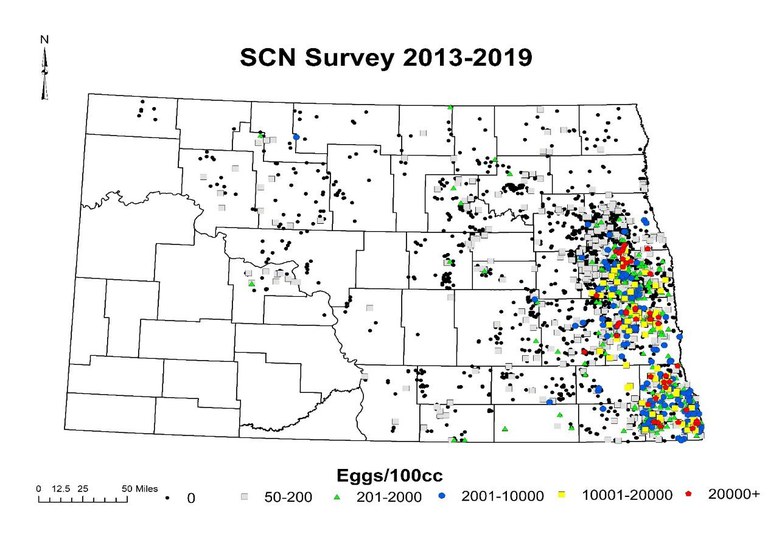Soybean harvest season is also time to soil sample for soybean cyst nematode
Soybean harvest currently is a common farm activity. Another activity that farmers are encouraged to do during early October is to soil sample for soybean cyst nematode (SCN). This task can actually be done before or after harvest (or during harvest while you are waiting to fill a grain wagon or truck), and will coincide with the highest SCN egg levels in the soil.

Soil analysis results for SCN in North Dakota from 2013-2019.
NDSU Extension, in cooperation with the North Dakota Soybean Council (who provides funding for soil analysis), has information and bags for soil sampling that can be obtained at county Extension and Research Extension Center offices.
SCN is a parasitic nematode that will complete two to three life cycles each growing season. Each female will produce 100-200 eggs, which are protected within her body wall after she dies (called a ‘cyst’). When we soil sample, we are measuring the amount of eggs in the soil.
When sampling, aim for the roots, sample right next to the plant or harvested row. You only need to go 6-8 inches deep. Take 10-20 small samples, mix, and fill soil bag with the composite sample.
SCN moves with anything that moves soil, loves high pH, and often doesn’t show above ground symptoms. Consequently:
Focus on areas that are likely to introduce soil to your field, such as:
- Field entrances (SCN being moved on equipment with soil)
- Low spots where water pools (SCN moving in water)
- Frequently flooded areas (SCN moving in water)
- Along shelter belts or fence lines (SCN moving with wind-dispersed soil)
Additionally, several areas should be considered suspicious for SCN, and can be sampled.
- High pH spots in the field (SCN loves high pH).
- Areas with unexplained low yields (do the beans look fine but yield poorly in a spot?).
- Areas that turned yellow in August (heavy SCN damage may show up as stunted or yellow beans when it is hot and dry late in the season).
Results from soil analysis indicate eggs per hundred cc of soil (eggs/100cc). Samples with 50-200 eggs indicate very low levels and should be viewed as suspicious (but not necessarily confirmed). Numbers greater than 200 eggs should be viewed as a positive, and, should be managed. SCN can explode very quickly, so a find of 1,000 should be aggressively managed, so it doesn’t become 10 or 50 times higher after the next planting of soybeans or dry beans.
Adapted from information written by Sam Markell, NDSU Extension plant pathologist.
Greg Endres
Extension Cropping Systems Specialist
Gregory.Endres@ndsu.edu


